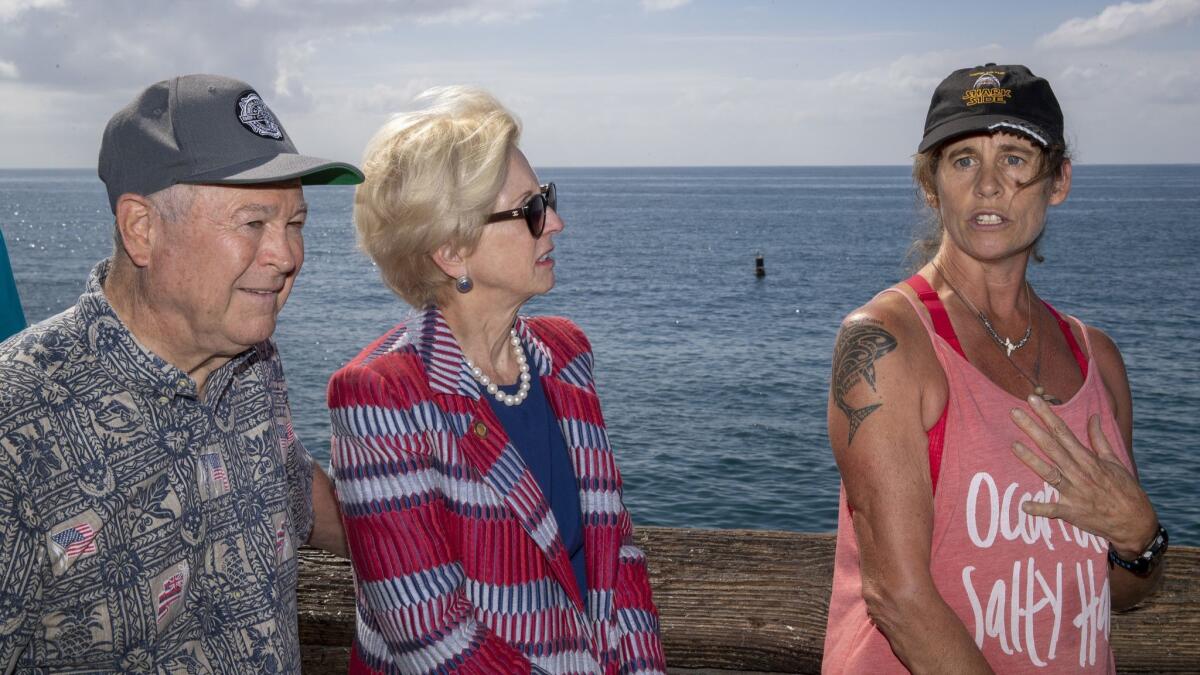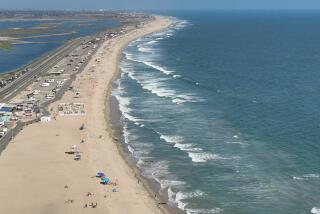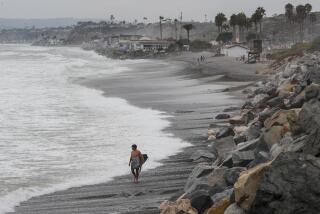Shark-detecting sonar buoy aimed at reducing attacks off Newport Beach coast

A shark-detecting buoy installed off the Balboa Pier in Newport Beach is the latest tool in Southern California lifeguards’ attempt to get ahead of a growing number of shark-related incidents in the region.
The system, called the Clever Buoy, became operational Wednesday as part of a 60-day pilot project to test the sonar-equipped device’s ability to alert lifeguards to sharks.
The Clever Buoy will monitor a 500- to 600-yard stretch of open water between lifeguard Tower B and Coronado Street.
The Clever Buoy has three sonar sensors that sit five feet off the ocean floor and communicate with a central buoy that will relay data to a communications tower on the pier. The nearby Junior Lifeguards headquarters will serve as a staging area for the equipment.
Together, the buoy and sensors can detect nearby marine life, and based on the swimming patterns, identify whether an animal is a shark, dolphin or school of fish.
The sensor system shares information with lifeguards through an app, alerting them within seconds when a shark is detected while providing information on the size, location and direction of travel, according to Richard Talmage, general manager of the device’s designer, Australia-based Smart Marine Systems, formerly Shark Mitigation Systems.
The buoy also will collect data on weather and water conditions, and an acoustic tag receiver will track any animals tagged by local researchers.
The launch in Newport Beach comes a year after the project’s announcement by U.S. Rep. Dana Rohrabacher (R-Costa Mesa), who initially proposed installing six sonar devices to monitor a roughly 1,000-yard stretch off Corona del Mar State Beach.
The beach, also known as “Big Corona,” was where swimmer Maria Korcsmaros was bitten by a shark in 2016 while training for an Ironman competition. Korcsmaros, of Corona, was 150 yards offshore when she suffered a bite on her right side that reached from her triceps to her pelvis.
Chris Lowe, head of the Shark Lab at Cal State Long Beach, estimated that, based on the size of the injury, the shark was an adult great white at least 10 feet long.
Korcsmaros, who was back in the water competing in a triathlon five months after the attack, attended Wednesday’s Clever Buoy launch and said she is enthusiastic about the project’s potential.
“If I feel safe in the water, I’ll go swimming,” she said.
Though Big Corona was the previously proposed site for the trial, state permitting processes proved extensive and lengthy, the Newport Beach Fire Department said.
Rohrabacher, a senior member of the House Committee on Science and Technology, said last year that he would be looking for federal funding to help launch the project. However, as of Wednesday, the pilot program is privately funded.
To buy the system outright would cost $500,000, the city said. Leasing it would cost $18,000 to $20,000 a month, not including the cost of installation, which depends on site conditions and the components being included, Smart Marine Systems said.
City officials said Newport Beach has no expenditures related to the project, though lifeguards have helped technicians with the installation and launch.
Rohrabacher previously speculated that the buoy alerts to lifeguards could one day be available to the public on a phone app.
However, SMS said how the system’s data are used and what should be relayed to the public are a task for lifeguards.
Rohrabacher, who also attended Wednesday’s event, called sharks off the Southern California coast a serious threat to surfers, junior lifeguards and visitors — a threat he experienced while surfing and that he said will “scare the hell out of you.”
Rohrabacher emphasized the impact of shark-related incidents not only on public safety but also on the local economy, noting that beach-going visitors bring millions of dollars a day in tourism-related revenue.
SMS co-founder Craig Anderson described crippling effects on tourism in Australia, which shares many characteristics with Newport’s beaches and weather.
Shark activity has increased in the past three to four years, with large numbers of juvenile white sharks reported, according to the Newport Beach Fire Department. Southern California waters serve as a nursery for white sharks.
In 2016, Newport Beach became the first city in Orange County to have a dedicated shark page on its website. The city also installed acoustic receivers at the Newport Pier, Balboa Pier and off Corona del Mar to gather information for the site.
Brent Jacobsen, Newport Beach acting chief lifeguard, said the department currently uses lifeguards, patrol boats, helicopters and drones to monitor sharks and investigate reports of sightings.
Jacobsen said he is interested to see whether the buoy “is able to detect possible threats very well or reveals that we have a lot of threats that we don’t know about.”
Nearby beach cities have added drones to their arsenal of shark-detection tools, but flying the devices over Newport Beach has unique obstacles. Because of restricted airspace due to the proximity to John Wayne Airport, the beaches are in highly regulated sections of coastline for launching drones.
“We have the ability to launch a drone if we need one,” Jacobsen said. However, he added, helicopter monitoring “is much more efficient” because copters offer better visibility over the water and can cover more ground.
The Newport Fire Department uses an Orange County Sheriff’s Department helicopter or one shared by the Newport and Huntington Beach police departments. Police have trained observers and the ability to photograph animals in the water if a threat is spotted.
Jacobsen recalled about a half-dozen reports of sightings in 2017 but said, “I don’t remember them finding a shark last year.”
Laguna Beach launched drones in response to about a dozen reports of shark sightings this year, though they were determined to be unfounded, according to Laguna marine safety Capt. Kai Bond.
Orange County has never had a documented fatal shark attack.
More to Read
Sign up for Essential California
The most important California stories and recommendations in your inbox every morning.
You may occasionally receive promotional content from the Los Angeles Times.










